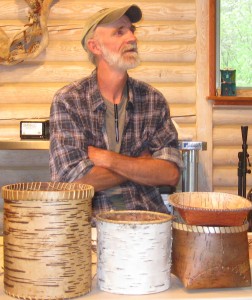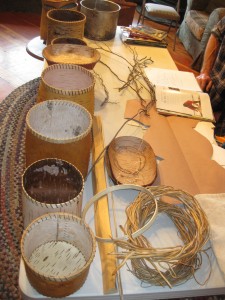Summary by Catherine Haug
Using Birch Bark and other Native Materials, by Steve Wingard
The following is a short outline of the event. For the complete gathering summary, including photos and links to websites offering online educational videos for many steps in the process, see our pdf file:
Gathering Summary: Using Birch Bark (8 pages)
Presentation Outline
- Uses for birch, a history
- Working with roots
- Working with bark
- Cedar hoops
- Assemble basket
- Different types of baskets
- Birch bark canoes
- Trout fishing nets
- Future Classes
The plight of birch trees
Steve didn’t discuss this during his presentation, but it is an issue that greatly troubles him. He asked that I add something about this.
Worldwide, birch trees are declining in number at a staggering rate, as they succumb to the bronze birch borer beetle. The experts believe the tree is already sick, with a weakened immune system, before the beetle does its damage. What is causing this sickness and the beetle problem?
“The good news is that healthy, well-situated, well-maintained birches are more resistant to the borer.” (from Birch-Tree.com)
Steve is collecting information on birches in different locales, and would appreciate knowing how your birches are faring. You can contact Steve at (406) 837-2546 or freeeemont(at)yahoo.com [NOTE: email disguised for security]. See also his website: stevewingard.com.
Growing Healthy Birch Trees
Birch is native to our area, and should do well here, were it not for the current problem. If you would like to add birches to your yard, here are some websites with helpful information:
- Birch-Tree.com: Birch Tree Care: A Step by Step Guide and Bronze Birch Borer
- US Government Leaflet: How to Grow and Maintain a Healthy Birch Tree
- US Forest Service Leaflet: Forest Insect and Disease Leaflet: Bronze Birch Borer
- Vinson Lab on Birch Borer Beetle

